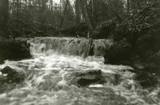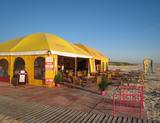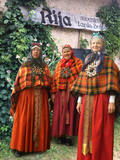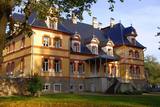| Nr | Nosaukums | Apraksts |
|---|---|---|
|
Kanjonveidīgu gravu komplekss, kas veidojies dolomīta slāņos, veidojot atsegumus un nelielus ūdenkritumus upītes gultnē. Lai arī Kalamecu - Markūzu gravas tiek bieži popularizētas un apmeklētas kā tūrisma objekts, tajās nav attiecīgs, šim mērķim paredzēts labiekārtojums!
|
||
|
Mīlestības saliņas paviljons - rotonda –
celta klasicisma stilā 1928. g. Savulaik te bija
laivu piestātne. Līdz šim nolaisto un
apmeklēšanai bīstamo objektu plānots
atjaunot.
|
||
|
Krodziņš atrodas Jelgavas centrā pie tilta pār Driksu, ko ieskauj jaunizveidotā krasta promenāde. Interjerā izmantoti koka elementi. Regulāri rīko muzikālus vakarus. Latviešu virtuve: Aukstā zupa, cepta butes vai mencas fileja, zemnieku brokastis, kartupeļu un plānās pankūkas. |
||
|
Pludmales kafejnīca Jūrmalas ielas galā, pie pašas pludmales, Liepājā. Trešdienās, piektdienās un sestdienās "Vēju dārzā" dzīvā mūzika. Piedāvā brokastis, pusdienas, pusdienas, kafiju and dzērienus. |
||
|
Ideja par "DA'ZIEPE" radās iedvesmojoties no Amatas novada dabas un idejas par pilnvērtīgu pieejamo resursu izmantošanu. Ziepes tiek gatavotas no liellopu vai briežu taukiem, augu eļļām un ziepju zālēm, kā arī papildinātas ar dažādām ēteriskajām eļļām un dabīgajiem aromātiem. |
||
|
Meklējams Matsalu līča dienvidu krastā pie Kēmu ostas (Keemu sadam). Blakus sešus metrus augstajam metāla – koka tornim uzcelts neliels apmeklētāju centrs. Tāpat kā no Haeskas torņa, arī no šī paveras viena no izcilākajām Matsalu līča un tā piekrastes ainavām. Laba putnu vērošanas vieta migrāciju laikā. |
||
|
Piemiņas vieta ar pieminekli (atklāts 1936. g., tēlnieks: K. Zāle) 1. pasaules kara laika kritušajiem 38 karavīriem Smārdē pie Smārdes – Tukuma ceļa. No 1915. – 1917. g. frontes līnija atradās netālu no Smārdes. Kritušo bija daudz, tādēļ tie tika apbedīti turpat purvā. Tikai pēc kara tos pārapbedīja Smārdē, Kūdrā, Ķemeros un Slokā. |
||
|
Alsungas vecajā muižas rijā ir iekārtots suvenīru veikals, kur var iegādāties Suitu novadā ražotus praktiskus suvenīrus „Tapis Suitos” un citas noderīgas lietas: lakatus, cimdus, zeķes, traukus, zāļu tējas u.c. Bērniem te organizē radošās darbnīcas. Rijā var satikties (iepriekš piesakoties) ar Suitu sievām, uzzināt par suitu tradīcijām, dziedāt un iet rotaļās. „Rijai” piešķirta kultūras zīme „Latviskais mantojums”. |
||
|
Muižas ansamblis Milzkalnē - Slocenes upītes krastā ir sācis veidoties 15. gs. kā franku tipa slēgts komplekss ordeņa saimniecības vajadzībām un mūsdienās ir vienīgais saglabājies šāda tipa nocietinātas muižas (kā muižnieku patvēruma vieta uzbrukuma gadījumā) paraugs Latvijā. 17. gs. beigās tika uzcelti vārtu torņi ar grezniem vējrāžiem, bet 18. - 19. gs. - arī saimniecības ēkas. No sākotnējās apbūves saglabājies mūris ar šaujamlūkām. Vienā no kompleksa spārniem ir izvietots Latvijas Ceļu muzejs. Muižas galvenajā ēkā izveidotas naktsmītnes, te piedāvā ekskursijas un lauku labumu degustāciju. |
||
|
Šaursliežu dzelzceļa līnijas posms ar sliežu platumu 750 mm, kas savieno Alūksni un Gulbeni, ir daļa no kādreizējā Stukmaņu–Valkas dzelzceļa līnijas. Šobrīd tas ir Latvijā vienīgais funkcionējošais regulārās pasažieru satiksmes šaursliežu dzelzceļš. Bānītis kursē katru dienu. Alūksnes dienviddaļā celto Alūksnes stacijas ēku atklāja 1903. g. 33 km garo līniju, kurā ir 10 stacijas un pieturas punkti, bānītis veic ~ pusotras stundas laikā. Populāri ir ikgadējie Bānīša svētki, kas pulcina mazbānīša entuziastus. Vasaras sezonā tiek piedāvāti speciālie tvaika reisi ar restaurēto tvaika lokomotīvi “Ferdinands”. |
||
|
Apmeklētāji var iepazīt darbnīcu, vērot meistaru darbībā, veidot paši, kā arī iegādāties māla izstrādājumus (t.sk. dārza keramiku) un apskatīt skaisto dārzu. |
||
|
Celts uz bijušā kolhoza stāvlaukuma Dunduru pļavu rietumu pusē. No torņa otrā stāva lieliski pārskatāms viss pļavu masīvs līdz pat Džūkstes upei un Kauguru kanālam. Redzami arī dzīvei savvaļā pielāgotie mājlopi, pat, ja tie atrodas visattālākajā vietā. Putnu vērošanas vieta no pavasara līdz vasaras otrai pusei. |
||
|
Mostes muiža ir izvietojusies Mostes ezera krastā. Apkārtni grezno ne tikai kungu māja, bet arī vērienīgais historicisma stilā būvētais palīgēku komplekss. Muižas kompleksā ietilpst angļu stilā ierīkotais parks. Kungu mājā tagad atvērta skola, savukārt, atjaunotajā muižas kokapstrādes darbnīcā Mostes muižas viesu nams, bet bijušajā zirgu stallī darbojas Restauratoru darbnīca. Muižas pārvaldnieka mājā atrodas Mākslas un sociālās prakses centrs, bet bijusī lopu kūts ir pārveidota par koncertzāli. |
||
|
Dodieties ekskursijā, lai gūtu ieskatu lauku profesijā un dzīvesveidā, kā arī iegūtu jaunus iespaidus un labu atpūtu visai klasei. Ekskursijas laikā apmeklējiet kokapstrādes darbnīcu, kurā ražo visu saimniecībā nepieciešamo – solus, galdus, pakaramos, virtuves piederumus, pirts baļļas, mucas, lieliskus suvenīrus no koka u.c. Pēc tam apmeklējiet zemnieku saimniecību, kura ir viena no lielākajām un modernākajām zemnieku saimniecībām Zemgalē. Izbaudiet pusdienu pikniku Tērvetes dabas parkā. Ekskursijas noslēgumā dodieties uz maizes ceptuvi, lai izzinātu maizes cepšanas arodu, degustētu un iegādātos maiznīcas izstrādājumus. |
||
|
Krievu sētas (Vene talu) saimniece gatavo gardus krievu nacionālos ēdienus pēc savas vecvecmāmiņas receptēm. Viesus iepazīstina ar paražām un piedāvā bagātīgas degustācijas. Ir arī tējas salons, krievu ēdienu gatavošanas meistarklases. |
||
|
1991. gada 14. jūnijā Pēterupes draudzes baznīcas dārzā atklāta tēlnieka Zezostra Ķēdis piemiņas zīme represētajiem 1941. un 1949. gadā. (Avots: Saulkrastu TIC) |
||
|
Tūrisma gide Ineta Jansone piedāvā ekskursijas grupām pa Raganu purvu. Izveidota taka uz sēra dīķiem (koka celiņi 800 m garumā). Ekskursijas laikā Jūs uzzināsiet par augstā tipa purvu un unikālu biotopu – sēra avotu izplūdes vietu Ķemeru Nacionālā parka teritorijā. Šeit sastopami savdabīgi purva ezeriņi, piesātināti ar sēra baktēriju radītām nogulsnēm. Ezeriņu krastos sastopami īpašu sugu augi. Sēra dīķu apkaimē var sajust gaisā sērūdeņraža smaržu. |
||
|
Saimniecības darbības veidi: liellopu un jaunlopu, garšaugu, mētru un bērzu stādu audzēšana un realizācija. Tūrisma pakalpojumi - apskatāmas skulptūras no sūnām un citiem materiāliem, saimniecības un dzimtas vēsture, seni darbarīki, ārstniecības augu, garšaugu un dažādu veidu mētru kolekcija, putni un poniji. |
||
|
No dārza un meža ogām, pārmantojot paaudžu tradīcijas, gatavo mājas vīnu. Piedāvā 4 vīnu degustāciju ar uzkodām un filozofiskas sarunas par vīna gatavošanas receptēm. Produkcijas iegāde. |
||
|
Kādreizējā Mēmele. Vienīgā Lietuvas ostas pilsēta ar vecpilsētu. |
||
























